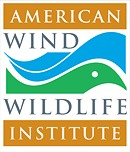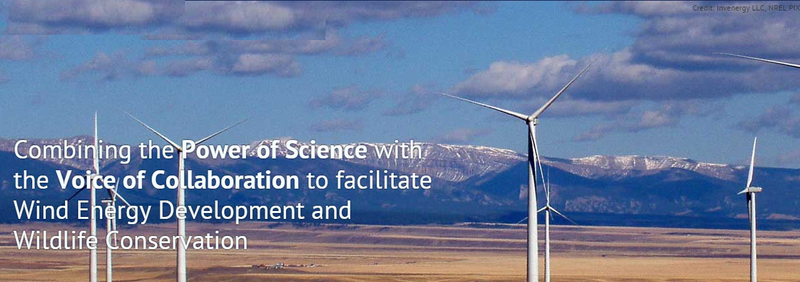News Release from windfair.net
Wind Industry Profile of
Editor's Choice - A fantastic tool to assess the impact of wind farms on endangered species

AWWI Mapping Initiative Background Information and Overview
The American Wind Wildlife Institute (AWWI) encourages sustainable wind energy development and recognizes that effective landscape-level wind energy project siting efforts, conservation plans, monitoring scenarios and mitigation strategies require a better understanding of relative wildlife sensitivities.
AWWI’s mapping initiative is using qualified data and best science to estimate relative wildlife sensitivities through a state-of-the-art landscape-scale, GIS mapping tool. The tool will initially focus on a pilot region (WY, MT, SD, ND, NE) and will then be expanded incrementally to a national scale with priority on states with the greatest wind resource potential. AWWI places a premium on transparency and credibility, and the tool will allow for the integration of new data on regular intervals.
The goal is to provide stakeholders with an initial baseline of wildlife sensitivity to consider in medium and long-range planning for wind energy development. AWWI recognizes that it is critical to learn from other national mapping processes; each process utilizes unique approaches with associated benefits and challenges. TNC analyzed these other efforts in order to derive lessons learned and apply them to AWWI’s mapping initiative. AWWI formed a Mapping Committee of wind industry representatives and wildlife experts (members listed below) to advise TNC in the technical development of the mapping tool.
- Andy Linehan, Iberdrola Renewables (chair)
- Steve Benson, Minnesota Division of Fish and Wildlife
- Kevin Doherty, Audubon Wyoming
- Rick Greiner, Pattern Energy
- Laurie Jodziewicz, American Wind Energy Association • Jay Pruett, The Nature Conservancy
Learning from Big Data – The American Wind Wildlife Information Center
Click on the Map to test the system
For more than 20 years, wind energy companies have undertaken studies to assess risk and impacts to wildlife from wind energy projects. Some data are publicly available but other data are privately owned. AWWI is building the American Wind Wildlife Information Center (AWWIC, pronounced ‘a-wic’; formerly known as the Research Information System), a first-of-its kind initiative, which will securely house wind-wildlife data and make it available for scientific analysis.
“The American Wind Wildlife Information Center will represent the most comprehensive information management tool available for wind-wildlife.” - Taber Allison, Ph.D., Director of Research and Evaluation, American Wind Wildlife Institute
Collection of existing data through the AWWIC is the most promising and efficient way to increase overall understanding of risks and impacts. The scientific analysis of the data in the AWWIC, which will be guided by AWWI, will:
- further understanding of wind-wildlife interactions & help minimize impacts
- refine questions and data collection for further analysis
- increase the cost-effectiveness of future research
- lower wind energy siting and operational costs and enhance permit review

Screening for Potential Wind-Wildlife Conflicts
To minimize risk, wind project developers and decision makers need cost-effective tools that enable them to screen locations for potential wildlife and habitat conflicts early in the siting process. AWWI and The Nature Conservancy (TNC) built and maintain the Landscape Assessment Tool (LAT), a GIS-based, publicly-available mapping tool that collates and displays biological information that is relevant to wind-energy development. Users can display web-based maps featuring information culled from over 1,000 data layers relevant to the identification of potential wildlife and environmental impacts and to landscape-level screening for potential project sites. The LAT is currently the only national decision support tool for energy development, with a focus on the data most relevant to wind energy.
The Landscape Assessment Tool - LAT
The LAT is designed as a landscape-level planning tool to identify sensitive wildlife habitat and areas that are likely to have low wildlife risk where wind energy development could be prioritized.
Although the siting of individual wind energy projects will require on-the-ground surveys to verify data shown here, our hope is that this tool will provide stakeholders with information that facilitates the siting of wind energy in areas with minimal impacts to wildlife, as well as the development of conservation plans, monitoring plans and mitigation strategies.

As mentioned above the LAT uses numerous data layers generated from public sources. These sources are limited by a high degree of variation in their accuracy and in the scales at which they function. This LAT is a general screening tool and may provide some guidance as to the environmental characteristics and important landscape-scale wildlife values of a geographic area.
This initial screening can offer early guidance about possible sensitivity of a site within a larger landscape context and could be used by wind developers for preliminary landscape scale assessment. The LAT, however, cannot be relied upon for actual and individual siting decisions. Those decisions must be made on the basis of locally-developed data and analyses, taking into consideration numerous factors, including factors unrelated to wildlife.

Driving the Development of Technological Solutions
AWWI’s collaborative network offers a unique opportunity to bring biologist together with engineers to explore challenges and opportunities related to technological solutions to wind-wildlife impacts. By creating a forum for this interaction, AWWI serves as an incubation space for new and exciting ideas that have the potential to drastically reduce the impacts of wind energy on sensitive species.
AWWI conducted a Request for Information (RFI) to gather information from vendors that have technology products available for immediate testing and/or deployment. The results of this RFI are compiled in a Technology Catalogmade available to AWWI Partners and Friends.
AWWI’s Technology Verification program coordinates testing, evaluation, and verification of available and in-development technologies intended to detect and deter raptor and bat species at wind energy facilities.
Verifying Detection and Deterrence Technologies
The Challenge
Many wind energy companies are turning to technology to minimize bird and bat collisions with wind turbines. Recent developments have focused on technologies intended to detect target species (such as eagles, whooping cranes, and condors) that are protected under state and federal laws. At some projects these detection devices are linked to automatic or manual shut down of turbines to avoid collisions. Other systems link the detection systems with devices intended to alert birds or bats to the presence of turbines or dissuade them from the rotor-swept area, reducing collision risk. Depending on their potential effectiveness, these technological strategies represent significant opportunities for minimization of bird and bat deaths at wind energy facilities.

While these technologies are potentially useful for wind companies, few have undergone independent testing to establish their effectiveness. Given the expense, time, and uncertainty associated with use of these technologies, regulators and wind facility operators are hesitant to make use of them without certainty of their effectiveness. Simultaneous and coordinated testing of technologies at multiple facilities will cut future costs by minimizing unnecessary repetition, provide the opportunity to verify efficacy in multiple locations and diverse environmental conditions, and establish statistically robust data from which to draw conclusions.
AWWI’s Approach - Technology Verification
AWWI has established a cooperative group of wind facility operators to host rigorous, credible verification of promising detection and deterrence technologies at their facilities. By pooling resources and expertise from the wind industry, AWWI will be able to transparently coordinate and replicate verification of available technologies, leading to more rapid and widespread adoption of successful technologies.
AWWI’s Technology Verification program coordinates testing, evaluation, and verification of available and in-development technologies intended to detect and deter raptor and bat species at wind energy facilities.
- Testing: AWWI contracts with researchers to conduct scientific tests at wind energy facilities that assess the efficacy of a technology to meet its goals of detection and/or deterrence of species based on predetermined metrics. Replicate tests of the same technology will be carried out at multiple facilities.
- Evaluation: AWWI coordinates the collection and analysis of results of testing from multiple facilities to determine the ability of the technology to meet its goals in different conditions.
- Verification: AWWI gathers the results of testing and evaluation to verify the overall efficacy of the technology. To promote transparency, increase credibility, and ensure buy-in, the results of the testing and evaluation will be submitted to peer-reviewed scientific journals as appropriate.
Please click here to access the Species Selection Criteria page and here to access the species list. On the website of the AWWI anyone can gain insight into endangered species and the impact the installation of wind farms could have on these.
Please click on diagramme to enlarge an to play around with the system
To receive more information on this article, our Newsletter or find out more about what w3.windfair.net has to offer, please, do not hesitate to contact Trevor Sievert at ts@windfair.net.
Please don't forget to follow us on Twitter: w3.windfair.net on Twitter
w3.windfair.net is the largest international B2B internet platform in wind energy – ultimately designed for connecting wind energy enthusiasts and companies across the globe.
- Source:
- American Wind Wildlife Institute (AWWI)
- Author:
- Trevor Sievert, Online Editorial Journalist / By AWWI Staff
- Email:
- ts@windfair.net
- Link:
- w3.windfair.net/...



